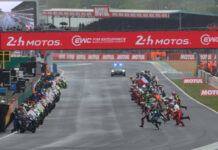Copyright 2001, Roadracing World Publishing, Inc.
AMA Pro Racing CEO Scott Hollingsworth’s vision for the future includes transforming the organization from a sanctioning body into a race promoting company independent from the parent AMA, with fewer classes at AMA Nationals.
Hollingsworth heads Paradama, Inc. (a.k.a. AMA Pro Racing), the for-profit subsidiary of the non-profit American Motorcyclist Association. Paradama was formed circa 1994 to compete head-to-head with Roger Edmondson’s NASB. Paradama promoted two of its own National races, suffering heavy losses, as part of a successful attempt to prevent Edmondson, the AMA’s former joint venture partner, from getting his rival NASB Series off the ground. The actions of the AMA and Paradama led to a lawsuit filed by Edmondson, which was recently settled when AMA and AMA Pro Racing paid Edmondson $3 million.
In the meantime, Paradama has served the same race-sanctioning function as Pro Racing did when it was a department within the non-profit AMA, instead of a for-profit subsidiary.
But there’s a limit to how much money a sanctioning body can charge traditional race promoters for a sanction, and to realize his vision for AMA Pro Racing, Hollingsworth must increase the company’s revenue dramatically.
Hollingsworth’s desire to increase AMA Pro Racing revenues has led to a bitter dispute with Clear Channel Motor Sports (formerly SFX Motor Sports and before that PACE Motor Sports), which promotes the wildly successful AMA-sanctioned Supercross Series.
Clear Channel executives have asked the question, “What is the Paradama? Is it a sanctioning body or a race promoter?” In their minds, the role of Paradama should remain what it always has been, that of a sanctioning body charging a reasonable sanctioning fee and providing a sanction and officials for races organized and promoted by companies like Clear Channel or by racetracks themselves.
Similar disputes with AMA road racing promoters may be on the horizon.
Race promoters like Clear Channel on the Supercross side and companies like Speedvision Productions–which puts on the Laguna Seca and Road Atlanta AMA Nationals–pay a sanction fee to the AMA and cover all the costs of holding a race, and keep the proceeds of race sponsorship sales and spectator ticket sales.
A promoter’s potential return from a successful race is far greater than the sanction fee currently collected by the AMA. But with that greater potential return comes greater potential risk. When AMA Pro Racing promoted its own Nationals and lost money, the parent AMA bailed out the company with serious injections of cash. And any time Paradama has needed money for any reason, it has gone to the AMA Board of Trustees for help, as in the case of paying its share of the Edmondson judgement.
Hollingsworth is looking for what he calls a “strategic partner” to provide the capital needed to promote races directly and to allow Paradama to split completely from the AMA.
The question of what will become of the established promoters of hugely successful AMA races like those at Daytona International Speedway, Road Atlanta, Road America, Mid-Ohio and Laguna Seca remains unresolved. In the case of races promoted by racetracks–like the events at Daytona, Road America, Mid-Ohio and Brainerd–it’s unknown if the track managers will allow the AMA to rent their facilities to promote a race instead of merely selling the track a sanction to promote its own race. If the track managers do allow their tracks to be rented, the rental fee is likely to increase dramatically.
Hollingsworth has no experience in motorcycle race promotion (or any race promotion), and has earned a reputation at AMA headquarters for ignoring advice from veteran AMA staffers. Instead, current and former AMA staffers say, Hollingsworth is quick to point out that he has an MBA degree while discounting their advice, and prefers to consult with people involved in various car-racing series.
Hollingsworth has also chafed under the supervision of the AMA Pro Racing Board of Directors, which is chosen by the AMA Board of Trustees, and seeks complete independence from the parent AMA and the accompanying “meddling” of Trustees.
By cutting ties between Paradama Inc. and the AMA, Hollingsworth would also be able to head off any attempts to change the direction he is taking Paradama through the election of reform-minded AMA Trustees. On the other hand, independence would also cut Paradama off from the periodic convenient financial bail-outs it has enjoyed as a subsidiary of AMA.
Hollingsworth’s plans ultimately call for AMA Nationals consisting only of Superbike and 600cc Supersport classes, because those are the classes that attract factory team involvement. Speaking of his plan at Daytona, Hollingsworth told one team owner, “I can’t help you if you’re not racing in Superbike or 600cc Supersport.”
While the full line-up of existing AMA classes is likely to be continued through 2002, the 250cc Grand Prix class will be eliminated for 2003, insiders say, with Pro Thunder, 750cc Supersport and Formula Xtreme also on the hit list.
Hollingsworth’s plans are likely to have a devastating effect on the AMA paddock, eliminating many independent riders and teams unable to compete successfully with factory-backed Superbike and 600cc Supersport teams. Such teams now compete in other support classes where they have a chance of success and an opportunity to develop riders, machines, mechanics and a sponsor base.
The elimination of the support classes would complete a recently accelerated AMA Pro Racing trend toward focusing on factory teams at the expense of the paddock at large.
For example, AMA Pro Racing officials have said that they want to eliminate the Thursday practice used by independent riders and teams to set up their bikes and get up to speed, in favor of using Thursday to park factory semi-trucks at AMA Nationals.
For another example of the shift of Paradama attention to factory teams, in recent weeks Hollingsworth visited factory teams and manufacturer headquarters to gather input. No such effort was made by Hollingsworth to gather any input from independent teams or riders.
Editorial Comment And Analysis: Hollingsworth’s Vision For AMA Pro Racing Includes Promoting Races With Fewer Classes, Less Oversight
Editorial Comment And Analysis: Hollingsworth’s Vision For AMA Pro Racing Includes Promoting Races With Fewer Classes, Less Oversight
© 2001, Roadracing World Publishing, Inc.






